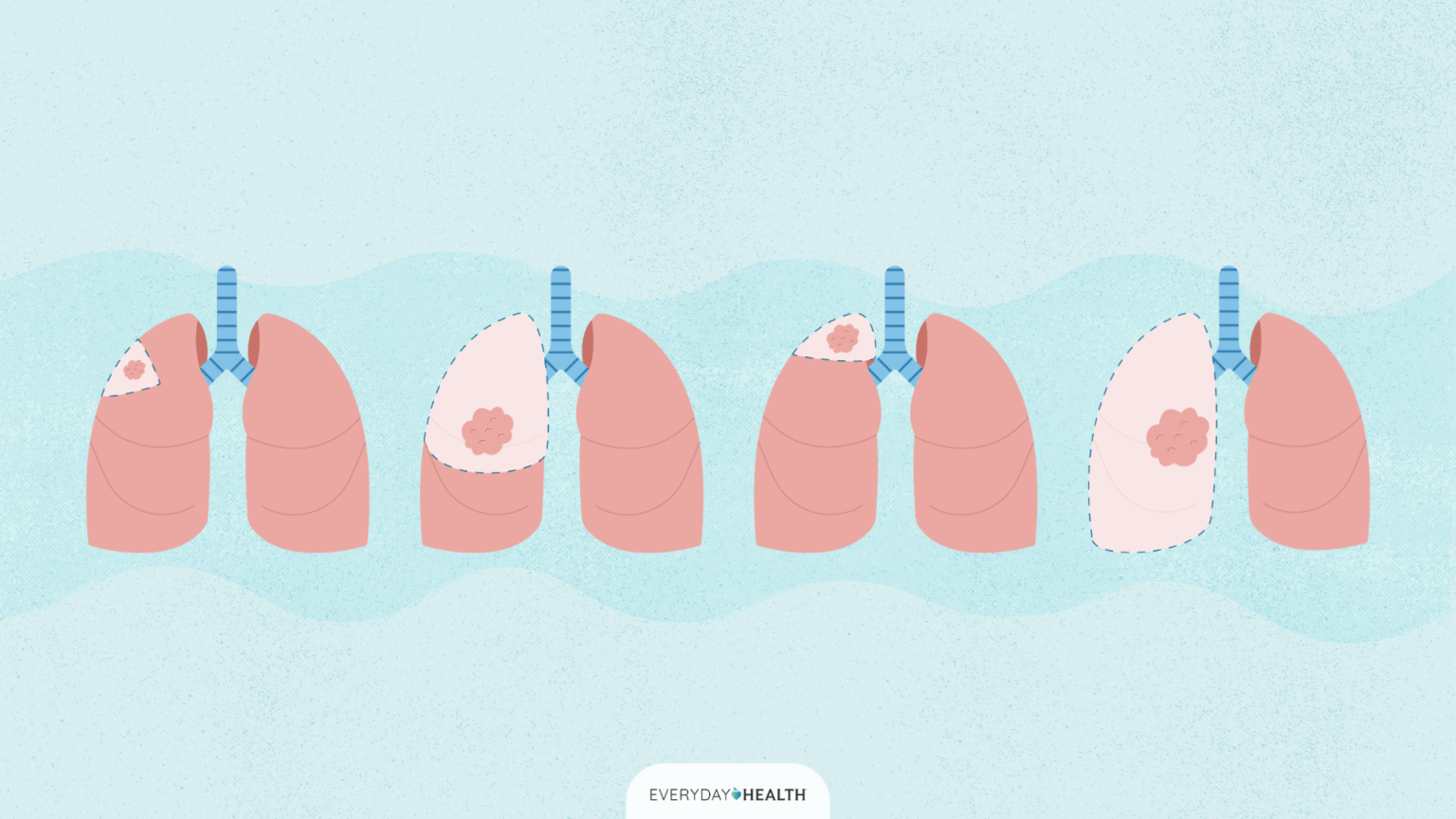Lung cancer surgery is the primary form of treatment for most cases of early stage lung cancer .e60dc2a1-f33c-4a05-9b50-8e3e8e5976291f7ea9b4-9b30-48a7-b5cb-e1af33d35743 Surgery is particularly effective in cases where the tumor hasn’t spread. It can help treat the cancer , improve outlook, and help patients live disease-free for a long time. In some cases of early-stage cancer, it may even cure the disease entirely.e60dc2a1-f33c-4a05-9b50-8e3e8e5976297cd72435-27ea-4da6-9dfa-674c48e4b849
Types of Lung Cancer Surgery Types Lung cancer surgery is also called lung resection, which means that part of the lung (or an entire lung) is being removed. These surgeries are performed by thoracic surgeons.e60dc2a1-f33c-4a05-9b50-8e3e8e5976297edcd103-4362-4e01-9577-88323fafb3bb
Wedge Resection During a wedge resection, the surgeon typically removes a small or wedge-shaped piece of lung tissue, which includes the tumor and a bit of surrounding healthy lung tissue.e60dc2a1-f33c-4a05-9b50-8e3e8e597629dfb4be79-ef13-40d4-9fee-2ef9832db039 A wedge resection is considered a “nonanatomic” procedure. This means that the intervention is less invasive, only a limited amount of tissue is removed, and the surgeon doesn’t follow along the lung’s anatomical lines when they perform the incisions. The procedure is usually done only on the outer parts of the lung.e60dc2a1-f33c-4a05-9b50-8e3e8e597629e3d1e0f8-e05a-4c7c-8f50-798adbb8adbb A wedge resection keeps most of the lung intact, but there is also a higher risk that the cancer can return because cancer cells may escape into the tissue that’s being preserved.e60dc2a1-f33c-4a05-9b50-8e3e8e597629914383be-bb4d-4982-aa1d-a22cbdec26c7 Lobectomy Your lungs have a total of five lobes: three on the right lung and two on the left. Lobectomy is the removal of one of the lung’s lobes, and it is the go-to surgery for non-small cell lung cancer (NSCLC) , the most common form of lung cancer.e60dc2a1-f33c-4a05-9b50-8e3e8e59762947ad1463-1a4b-4a00-a679-e07684ebd097 Segmental Resection Segmental lung resection, also known as segmentectomy, is a procedure in which only a small part of the lung’s lobe is removed, along with some nearby tissue.e60dc2a1-f33c-4a05-9b50-8e3e8e597629914383be-bb4d-4982-aa1d-a22cbdec26c7 Segmental resection is often recommended when the patient can’t have a full lobectomy, because they have other conditions that have affected their lung capacity too much. Segmental lung resection is often recommended in early-stage lung cancer. Compared with wedge resection, segmental resection is more demanding on the body, but it can also offer a better outlook in the long run.e60dc2a1-f33c-4a05-9b50-8e3e8e597629e3d1e0f8-e05a-4c7c-8f50-798adbb8adbb Pneumonectomy Pneumonectomy means removing an entire lung. It is a higher-risk procedure, with complication rates as high as 27 percent, according to some estimates.e60dc2a1-f33c-4a05-9b50-8e3e8e597629e3d1e0f8-e05a-4c7c-8f50-798adbb8adbb Pneumonectomy is usually recommended when other types of surgery aren’t suitable or when the tumor is too close to the center of the chest.e60dc2a1-f33c-4a05-9b50-8e3e8e597629e3d1e0f8-e05a-4c7c-8f50-798adbb8adbb
Who Typically Needs Lung Cancer Surgery? Why It’s Done People with early-stage NSCLC and carcinoid tumors usually need lung cancer surgery to remove the tumor and affected tissue. Surgery is the best choice when the tumor hasn’t spread, and some patients may not need additional therapy (like chemotherapy or radiation) to treat their cancer.e60dc2a1-f33c-4a05-9b50-8e3e8e597629f2d0797a-2560-4574-b8c8-a1522093435ae60dc2a1-f33c-4a05-9b50-8e3e8e5976294da9d189-c2e9-4a35-bb24-35ef2240ab31 In contrast, patients with a more advanced stage of lung cancer will need other treatments in addition to surgery.e60dc2a1-f33c-4a05-9b50-8e3e8e5976294da9d189-c2e9-4a35-bb24-35ef2240ab31
How Is Lung Cancer Surgery Performed? How It’s Performed Lung cancer surgery can be performed in one of two main ways: through a larger incision between the ribs (a procedure called a thoracotomy), or through minimally invasive surgery. In a minimally invasive procedure, the surgeon makes very small incisions and uses a small camera and tiny instruments to reach the lung.e60dc2a1-f33c-4a05-9b50-8e3e8e59762991916d1d-e4a9-4b92-8ac2-7172c55def46 The choice between these two ways of performing the surgery will depend on several factors, including the extent of the cancer and where the tumor is located.e60dc2a1-f33c-4a05-9b50-8e3e8e59762991916d1d-e4a9-4b92-8ac2-7172c55def46 Thoracotomy If you’re having a thoracotomy, a healthcare professional will place a breathing tube into your airway while you’re under anesthesia so that your lungs can continue to “‘breathe”’ during the surgery.e60dc2a1-f33c-4a05-9b50-8e3e8e5976291fa31eb1-1c5a-4b36-8d84-aaa07ae9581d Then, your surgeon will make a six-inch incision on the side of the chest that’s being operated on, just below your shoulder blade. This is usually between the fifth and sixth rib. You’ll have a chest tube inserted on the same side to help drain any excess fluid.e60dc2a1-f33c-4a05-9b50-8e3e8e5976291fa31eb1-1c5a-4b36-8d84-aaa07ae9581d Your healthcare team will also use a device that gently spreads the ribs so that the surgeon can access your lung.e60dc2a1-f33c-4a05-9b50-8e3e8e59762991916d1d-e4a9-4b92-8ac2-7172c55def46e60dc2a1-f33c-4a05-9b50-8e3e8e597629725ac60d-cd39-46e4-b0dc-6ed2142a446e Minimally Invasive Surgery Minimally invasive surgery usually requires one to four small incisions.e60dc2a1-f33c-4a05-9b50-8e3e8e59762991916d1d-e4a9-4b92-8ac2-7172c55def46 The surgery can be video-assisted or robotic-assisted. In video-assisted surgery, a small tube with a video camera at the end is inserted through a small incision between the ribs, offering the surgeon a magnified view of the lungs.e60dc2a1-f33c-4a05-9b50-8e3e8e59762991916d1d-e4a9-4b92-8ac2-7172c55def46 In robotic-assisted surgery, your surgeon sits next to you and controls the robotic surgical system through a console. The system has several arms that hold surgical instruments and one arm that holds the camera. The robotic system replicates the surgeon’s hand movements with extreme precision.e60dc2a1-f33c-4a05-9b50-8e3e8e59762991916d1d-e4a9-4b92-8ac2-7172c55def46 Compared with thoracotomy, minimally invasive surgery often involves a shorter hospital stay and faster recovery.e60dc2a1-f33c-4a05-9b50-8e3e8e59762991916d1d-e4a9-4b92-8ac2-7172c55def46e60dc2a1-f33c-4a05-9b50-8e3e8e597629725ac60d-cd39-46e4-b0dc-6ed2142a446e
How Do I Prepare for Lung Cancer Surgery? How to Prepare Before your lung cancer surgery, there are a few things you can do to ensure your procedure goes as smoothly as possible.e60dc2a1-f33c-4a05-9b50-8e3e8e597629dd7c095d-0bc7-4161-9eac-16454bfc4fed If you smoke, quit. Quitting smoking improves your chances of a faster recovery. Arrange for someone to take you to the hospital and pick you up when you’re discharged. Arrange for someone to help around your home while you recover. Take time off work to ensure you have plenty of time to recover. Ask your healthcare team what you’re allowed to eat and drink before the procedure. Make sure you understand what’s covered and what’s not covered by your insurance plan, and ask questions if anything’s not clear. Continue to take your current medications, unless your doctor says otherwise.e60dc2a1-f33c-4a05-9b50-8e3e8e5976298c18e031-4347-4841-9c40-49517c2cfaf8 Follow any other instructions given to you by your doctor or healthcare team.
What Should I Expect During Lung Cancer Surgery? What to Expect The surgery can last anywhere between three and six hours, depending on the type of surgery you have.e60dc2a1-f33c-4a05-9b50-8e3e8e597629f4886c88-f4d7-4b52-9539-e05a4c80d894 Before the procedure, the area that will be operated on may be cleaned and shaved to avoid infection.e60dc2a1-f33c-4a05-9b50-8e3e8e597629cefdebbf-f394-4954-b4e2-e5f6b996f729 During the procedure, you’ll typically be sedated (under general anesthesia).e60dc2a1-f33c-4a05-9b50-8e3e8e597629f4886c88-f4d7-4b52-9539-e05a4c80d894 After the procedure, you will be moved into a recovery room and eventually to your hospital room. It’s common for people to wake up feeling pain and grogginess. You will receive medication for the pain.e60dc2a1-f33c-4a05-9b50-8e3e8e597629cefdebbf-f394-4954-b4e2-e5f6b996f729
What Are the Potential Risks and Complications Associated With Lung Cancer Surgery? Risks and Complications No surgery is without risks, and lung cancer surgery is a major procedure. Short-term risks (which may occur up to 30 days after surgery) include:e60dc2a1-f33c-4a05-9b50-8e3e8e59762930f4dd23-c31b-4bd2-af8d-3c40f7f4d28de60dc2a1-f33c-4a05-9b50-8e3e8e597629102168e3-fe82-4b22-b408-ab7a5419a758 Infection Bleeding Pain Air leakage from the lung Pulmonary edema (a buildup of fluid in the lungs) Hemothorax (a buildup of blood in the pleural cavity, the space between the lungs and the chest wall) Adult respiratory distress syndrome (ARDS) Pneumonia Irregular heartbeat ( arrhythmia ) Blood clots in the lungs ( pulmonary embolism ) Other possible complications that can occur at a later stage include:e60dc2a1-f33c-4a05-9b50-8e3e8e597629102168e3-fe82-4b22-b408-ab7a5419a758e60dc2a1-f33c-4a05-9b50-8e3e8e59762924f60029-0993-4355-931c-f6bc1ff478ab Post-thoracotomy pain syndrome, which causes chest pain from nerve damage that may continue for months after surgery Bronchial stenosis (narrowing of the airways) Esophagopleural fistula, an abnormal space between the esophagus (food pipe) and the pleural cavity Bronchopleural fistula, an abnormal space between the airways and the pleural cavity Life-threatening complications or mortality from surgery are rare.e60dc2a1-f33c-4a05-9b50-8e3e8e59762930f4dd23-c31b-4bd2-af8d-3c40f7f4d28d e60dc2a1-f33c-4a05-9b50-8e3e8e59762924f60029-0993-4355-931c-f6bc1ff478ab
What Type of Care Is Needed After Lung Cancer Surgery? Follow-Up Care Most people stay two to three days in the hospital, but some may stay for longer, depending on the type of surgery they’ve had and how well they’re recovering.e60dc2a1-f33c-4a05-9b50-8e3e8e5976295e108c95-4184-4e7c-adca-d5b6c61fbf50 Chest tubes are commonly used, and your healthcare team will have placed those during surgery to help drain fluid from your chest. The chest tubes are usually removed after a couple of days, although some patients need to be discharged while still carrying them. If that’s the case, your healthcare team will explain how to care for the tubes at home.e60dc2a1-f33c-4a05-9b50-8e3e8e59762945401627-0b55-4153-925d-f52ed3903f29 Your team will also give you other instructions for recovery and will show you how to change your bandages at home. You may also have a respiratory therapist available to help improve your lung function after surgery.e60dc2a1-f33c-4a05-9b50-8e3e8e59762945401627-0b55-4153-925d-f52ed3903f29 Recovery can last anywhere between a few weeks and a couple of months. This will depend on various factors, like your overall health and the type of surgery you’ve had. Make sure you give yourself plenty of time off work, if possible, and patience to recover.e60dc2a1-f33c-4a05-9b50-8e3e8e5976295e108c95-4184-4e7c-adca-d5b6c61fbf50
What’s Next Your doctor will schedule follow-up appointments, usually a few weeks after surgery. These are important to keep.e60dc2a1-f33c-4a05-9b50-8e3e8e5976295a25b7c1-2f4a-4c12-abdf-9d849aafc42a During the appointment, your doctor will share with you the results of the surgery, examine you, and ask how you’ve been feeling and getting along in your recovery.e60dc2a1-f33c-4a05-9b50-8e3e8e597629bfd68794-6c19-4a90-9f31-34603d9035dd Certain symptoms after surgery could signal complications and require medical attention. Contact your healthcare professional if you have of the following symptoms:e60dc2a1-f33c-4a05-9b50-8e3e8e5976298f40004e-da41-4389-af4a-a0fcc36017e1 Excessive bleeding Coughing up excessive mucus Bad-smelling discharge from the incisions Fever Nausea or vomiting Pain that won’t go away with medication The following symptoms require urgent medical attention: Sudden chest pain Trouble breathing or shortness of breath Coughing up blood Loss of consciousness
The Takeaway Lung cancer surgery is the most effective way of treating non-small cell lung cancer that hasn’t spread. There are several types of lung cancer surgery, including wedge resection, lobectomy, segmental resection, and pneumonectomy. These can be performed as a thoracotomy (open lung surgery) or minimally invasive surgery. Lung cancer surgery is a major operation that comes with risks and a significant recovery period. Your healthcare team will support you throughout the process, so don’t hesitate to ask questions and reach out for help. Depending on the extent of the cancer and your overall health, lung cancer surgery can help you live disease-free for many years or even completely cure the cancer.
Read the full article here
Leave a comment




